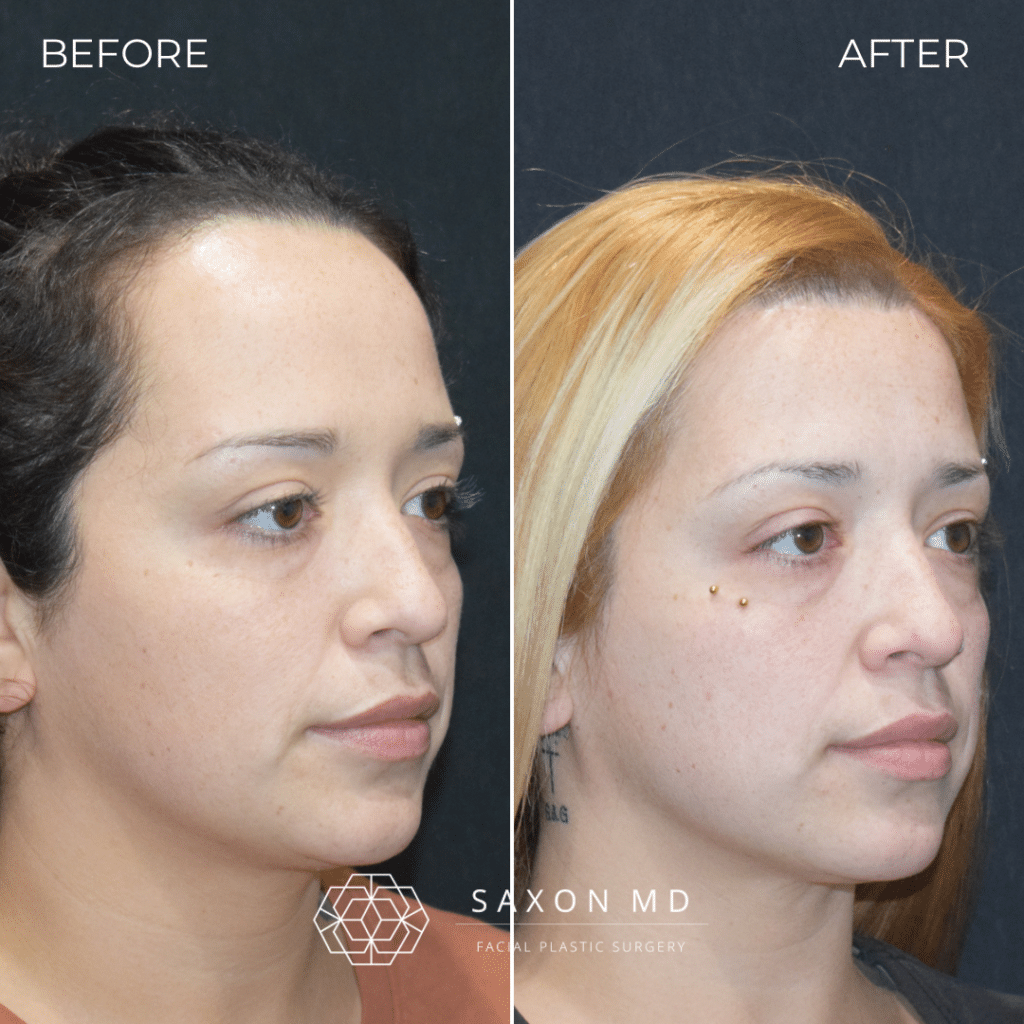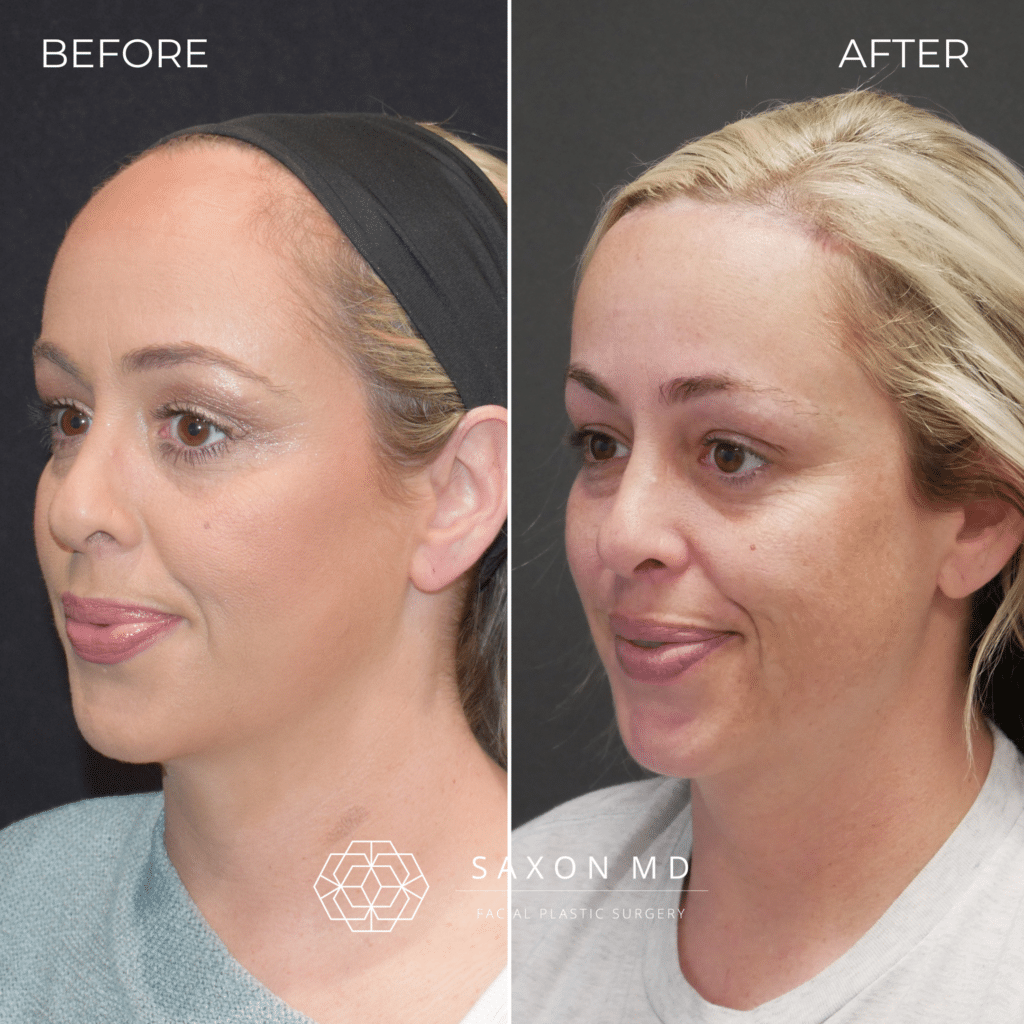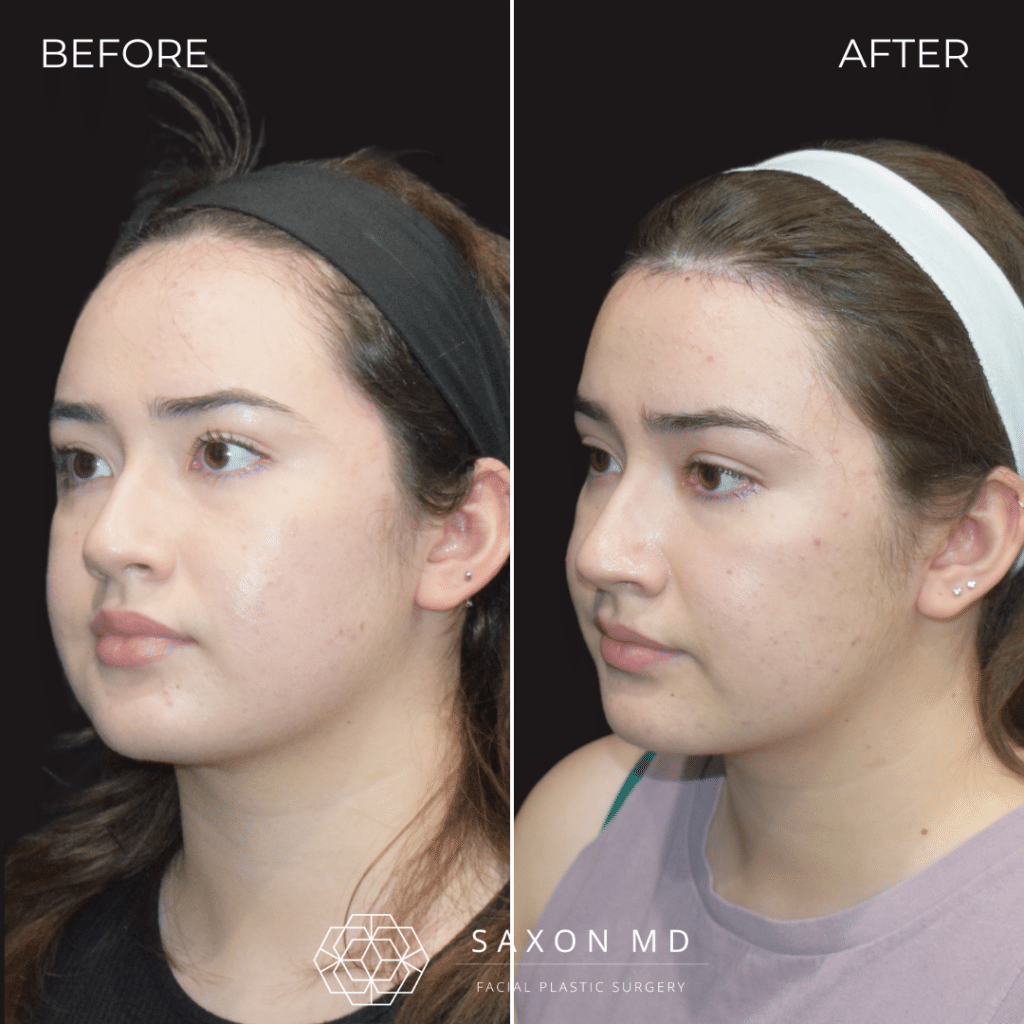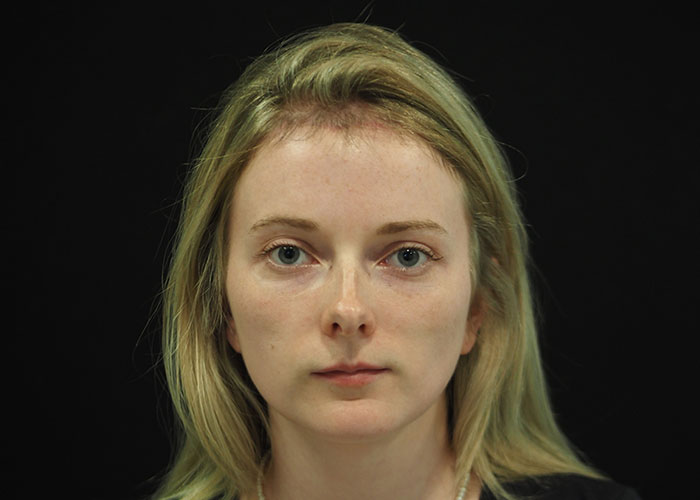Forehead Reduction Surgery (Hairline Lowering)
Forehead

Transform Your Forehead with Hairline Lowering
Dreaming of a more balanced facial profile? Hairline lowering (forehead reduction) can be the answer. Dr. Saxon, a leading expert in the procedure, helps patients achieve a more youthful and proportional appearance by adjusting the hairline position. This procedure reduces the forehead size with long-lasting results.
Dreaming of a more balanced facial profile? Hairline lowering (forehead reduction) can be the answer. Dr. Saxon, a leading expert in hairline lowering surgery, helps patients achieve a more youthful and proportional appearance by adjusting the hairline position. This procedure reduces the forehead size for long-lasting results. Schedule a consultation to explore if hairline lowering is right for you.
Benefits of Hairline Lowering

Benefits of Hairline Lowering?
- Lower, more natural hairline position
- Improved self-confidence and self-esteem
- Ability to wear different hairstyles
- A more proportionate and balanced facial appearance
Hairline lowering, also known as forehead reduction, is a surgical procedure performed by Dr. Saxon for individuals with a high hairline. This technique adjusts the hairline position, reducing the size of the forehead and offering a more balanced facial appearance.
Dr. Saxon performs more hairline lowering procedures than almost any other surgeon, so she routinely has patients travel to Texas from across the country for her expertise. Patients who have hairline lowering are among the happiest since many who seek out the procedure have been self-conscious about their hairline for their entire life.
Hairline lowering can be performed alone or in combination with other procedures such as brow bone reduction and brow lift. This surgery can help you achieve harmonious facial proportion, turning what some call a “five head” into a more traditionally proportioned forehead.
Am I a Candidate for Hairline Lowering?

If you are not satisfied with your hairline location, you might be a suitable candidate for hairline lowering. There are few contraindications for the procedure in women, including alopecia, active hair loss, and skin disorders of the scalp.
For men, the hairline may continue to recede over time, so they will want to ensure that hair loss is stable before undergoing the procedure. In this situation, there is still a chance hair grafting may be needed in the future should hair loss continue.
In women, estrogen usually prevents the hairline from changing drastically, and undergoing this procedure at any time is generally safe. During a comprehensive consultation with Dr. Saxon, she will review your medical history and examine your scalp to determine if you are a good candidate for hairline lowering.
- Avoid taking medications or supplements that can increase bleeding, such as aspirin.
- It is okay to take vitamins that promote hair growth, such as Nutrafol or Viviscal
- Stop smoking at least four weeks before the procedure to promote better healing.
- Arrange for someone to drive you home post-surgery and assist you for the first 24 hours.
- Refrain from eating or drinking after midnight the night before surgery.
- Inform Dr. Saxon of any sudden health changes or new medications.
- Set up a recovery area at home with ice packs, post-op supplies, and pillows.
- Arrive at the surgery center without makeup, lash extensions, or jewelry.
- Follow any pre-operative instructions provided by Dr. Saxon closely.
Dr. Saxon’s Unique Approach
Dr. Saxon takes a distinctive approach to hairline lowering. She designs the incisions in order to round off the hairline and ensure that scars are well-hidden. Her attention to detail in how she closes the incisions also aims to minimize scarring. She also incorporates regenerative treatments like exosomes and platelet rich fibrin to minimize the risk of hair loss and improve overall healing. Over time, Dr. Saxon has become nationally recognized as one of the few experts in hairline lowering both for her surgical technique and post op skin regimen to maintain natural results with as little downtime as possible.
Hairline Lowering Recovery
Hairline lowering has a fairly short recovery time. Immediately after surgery, a compressive wrap is placed around the forehead. It can be removed daily for hair washing and cleaning incisions. There is mild swelling and bruising, which descends with gravity down around the eyes and cheeks. The forehead tends to be numb temporarily, which minimizes pain. Any clips and sutures are removed one week after surgery, and local wound care will continue for one week after that. Sunscreen and silicone-based scar gels are recommended after that time. Hair usually starts to grow through the incision 2-6 months after surgery.
Remember to follow all aftercare instructions provided by Dr. Saxon, including:
- Resting and elevating your head to reduce swelling.
- Avoiding strenuous activities and heavy lifting for at least two weeks.
- Taking all prescribed medications as directed.
- Avoiding hair dyes and chemical treatments for at least six weeks.
- Protecting your forehead from direct sunlight and using sunscreen regularly.
- Attending all follow-up appointments to monitor healing progress.
- Reporting any unusual symptoms or concerns to Dr. Saxon immediately.
- Maintaining a balanced diet and staying hydrated to support healing.
- Avoiding alcohol and smoking, as they can slow down recovery.
Hairline Lowering FAQs
Is hairline lowering suitable for both men and women?
Yes, hairline lowering can technically be performed on both men and women to address high or receding hairlines and improve facial proportions. However, Dr. Saxon generally recommends hair grafts for men since the hairline can continue to recede with age exposing the incision. Read about hairline lowering vs hair grafts in our blog.
How long does the procedure typically take?
The surgery typically takes about 2 hours, but the exact duration can vary depending on individual factors and the complexity of the case.
How much does hairline lowering cost?
Will there be visible scars after hairline lowering?
Dr. Saxon uses meticulous techniques to minimize scarring. Incisions are usually made within the hairline or along its natural contours, ensuring scars are discreet and often imperceptible. There are ways to camouflage scarring while it is healing and improve the overall appearance.
What is the downtime after hairline lowering surgery?
When can I expect to see the final results?
While some immediate improvements will be noticeable, the final results of hairline lowering typically become more apparent over a few months as any residual swelling subsides and the scalp settles into its new position. Hair starts to grow through the incision between 3-6 months after surgery, and redness starts to subside.
Are there any potential risks or complications associated with this procedure?
As with any surgical procedure, there are some risks involved, including infection, scarring, shock hair loss, and anesthesia-related complications. Dr. Saxon will thoroughly discuss potential risks during your consultation and offer aftercare guidelines to minimize the risks.
- Hair Restoration, Hairline Lowering
Receding Hairline in Women: What Causes It and How to Treat It If you’re concerned about a receding hairline, you’re
- Hairline Lowering
Why a Perfectly Straight Hairline Looks Fake When patients come in for hairline lowering (also known as forehead reduction) surgery,
- Brow Bone Reduction, Brow Lift, Hairline Lowering
How to Get a Smaller Forehead If you’ve ever looked in the mirror and felt like your forehead dominates your
- Hairline Lowering
Forehead reduction surgery, also known as hairline lowering, has gained popularity in recent years, particularly through social media platforms like
- Brow Bone Reduction, Brow Lift, Facial Feminization, Hairline Lowering
The upper third of the face is a crucial element in defining the overall appearance and gender perception of the
- Hairline Lowering
6 Factors That Determine the Amount of Hair Growth Through the Incision After Hairline Lowering Surgery Hairline lowering surgery, also
- Hairline Lowering
Top 5 Things You Wish You Knew Before Hairline Lowering Hairline lowering surgery, also known as forehead reduction surgery, is
- Hairline Lowering
How to Camouflage Your Hairline Lowering Incision After Surgery Undergoing hairline lowering surgery can be a transformative experience, giving you



